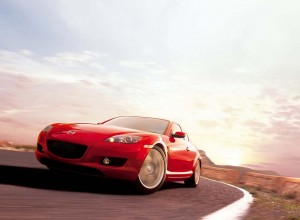The rotary engine is in for a revival, or so it might seem based on a tweet posted – in Japanese by the PR folks at Mazda headquarters in Hiroshima.
It suggests a “new model with next-generation rotary engine” is in the works, confirming a report by TheDetroitBureau.com several months ago.
At the time, the senior executive on the maker’s new SkyActiv program, Kiyoshi Fujiwara, told TDB he was continuing to work on the Wankel engine almost as a skunk works project, even though it did not have the official corporate green light. (For the full story, Click Here.)
Now, it appears, the next-gen rotary program is on the official program, though the Mazda posting did not provide any details, according to our friends at Autoblog.com.
The rotary engine has been a favorite for many tech aficionados since the 1960s, when it made its first appearance in Europe in an NSU and, shortly afterwards a Mazda. In fact, it appeared that the Wankel would become an automotive mainstay, with manufacturers as diverse as General Motors and AMC planning to put it into production.
Unfortunately, they didn’t take into account energy costs. While the Wankel is great at making lots of power from an incredible small displacement it has inherent design problems that also cause it to burn tremendous amounts of fuel.
That’s why Mazda had been playing to abandon the rotary with the upcoming halt of production of the RX-8 sports car.
But insiders simply weren’t ready to walk away from the technology and, during a background session in Vancouver, two months ago, Fujiwara said he had solved two of the rotary’s three main problems – though he declined to offer details – and thought it possible to address the remaining technical challenge over the next few years.
To get there Mazda will apparently rely on some of the new systems developed for the Japanese maker’s new Skyactiv powertrains. Both gas and diesel engines have been developed to run on compression ratios of about 14:1 using advanced turbocharging and high-pressure fuel injection, among other things.
The first car to use both the Skyactive powertrain and chassis technologies will be the CX-5, which comes to market in the U.S. next year. A Mazda diesel is notably also planned for the States.
When the rotary will reappear, however, is something that we may have to wait for another tweet from Hiroshima to find out about.


“ While the Wankel is great at making lots of power …it has inherent design problems that also cost them to burn a tremendous amount of fuel ”
“ …Fugivara has said he had solved two of the rotary’s three main problems –though he declined to offer details- and thought it possible to address the remaining technical challenge over the next few years ”
A friend used to run an RX7 with Wankel and then an RX8 with the “revolutionary improved” Wankel renesis, experiencing the oil burning problem, along with the “tremendous amount of fuel” you are talking about.
The heated catalyst was great in hiding the oil problem.
But he had to check / add oil at the frequent refueling in the pump-station, and to explain to his unfamiliar companion “what was that?”
Worse even, he was driving a gas-guzzler consuming and polluting as much as three conventional cars.
Doesn’t it makes more sense, instead of investing more on the Wankel, Mazda to take a look at other unconventional greener engines like the PatPortLess at http://www.pattakon.com/pattakonPatPortLess.htm
that combines the advantages of the conventional 2-stroke with true 4-stroke lubrication / lube specific consumption, better than 4-stroke specific fuel consumption and 4-stroke scuffing resistance / reliability.
Or like the PatMar at http://www.pattakon.com/pattakonPatMar.htm
Thanks
Manousos Pattakos